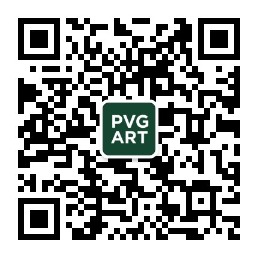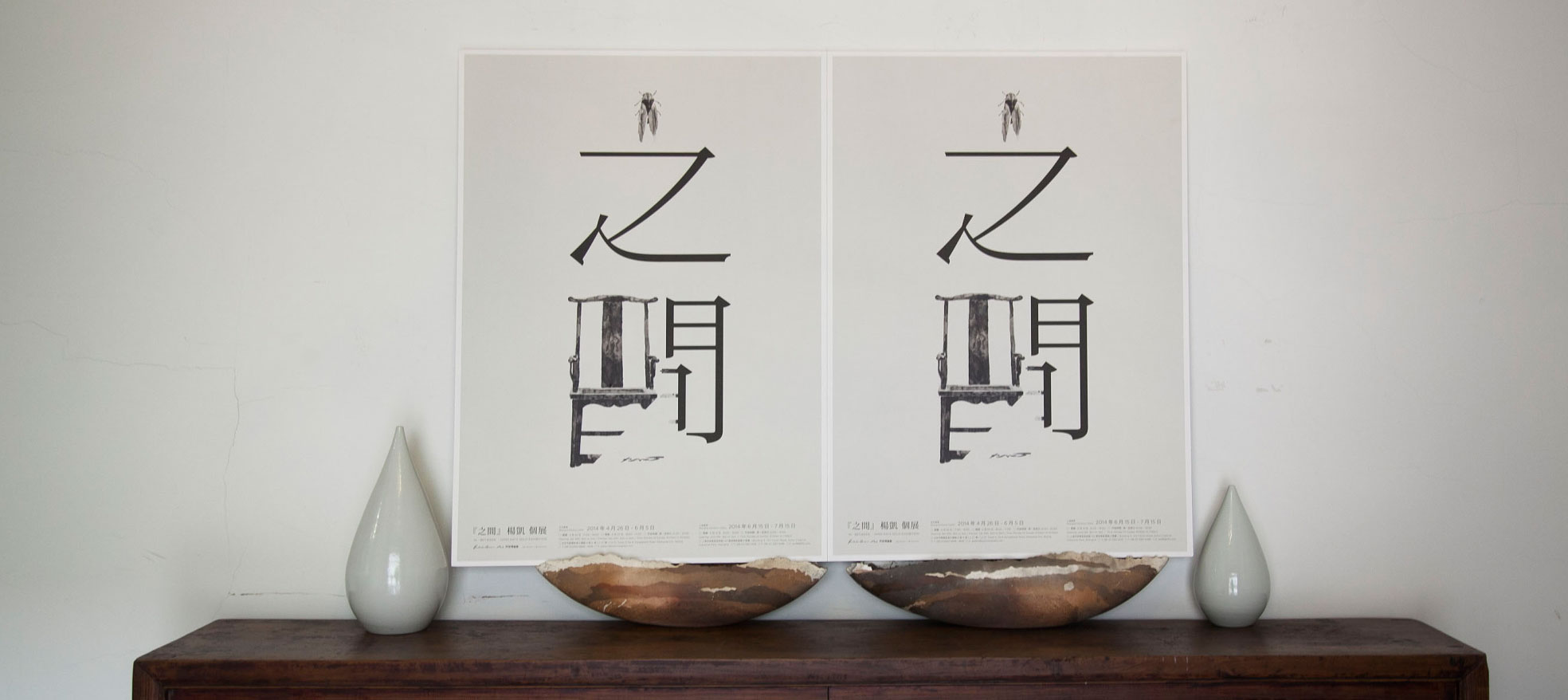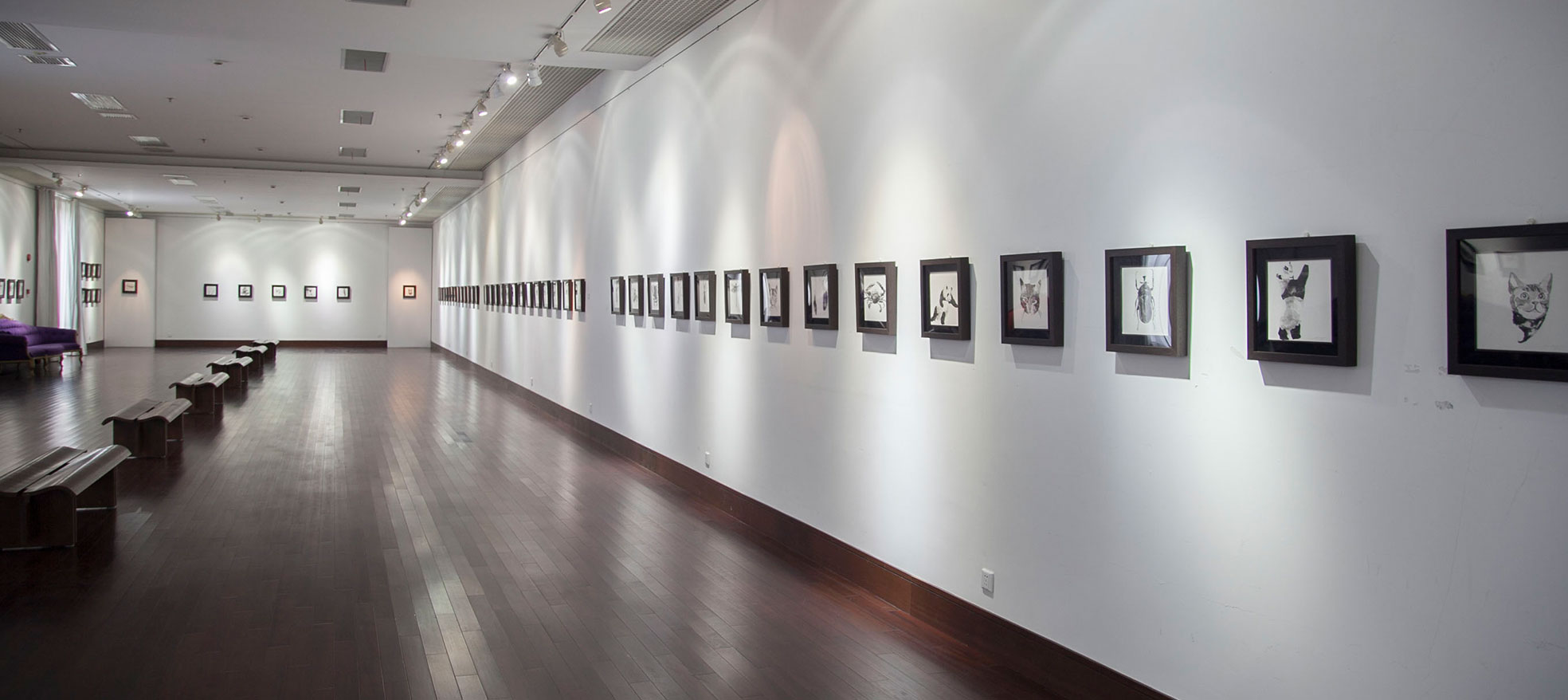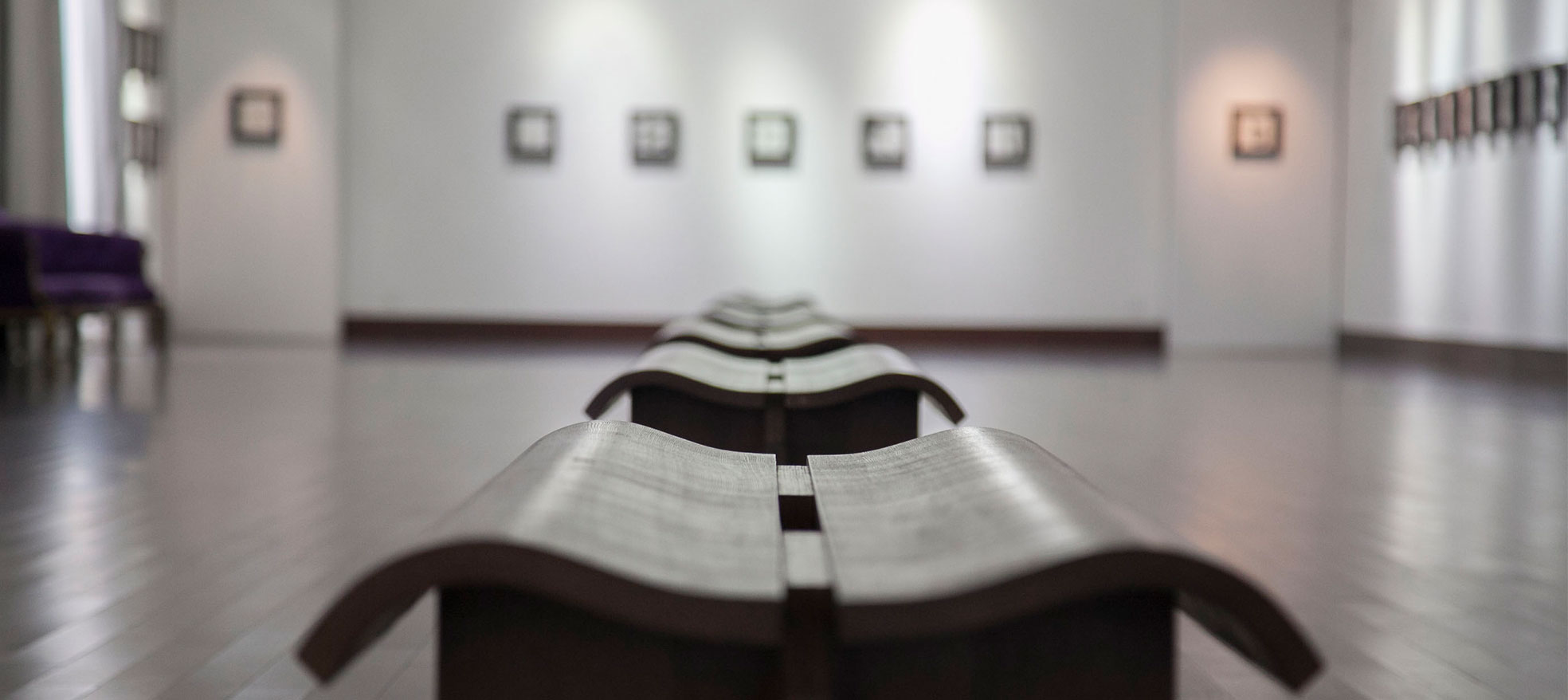Unfamiliarity: Another Possibility of Tradition
Hang Chunxiao
Yang Kai is obviously not a Chinese ink painting artist in the traditional sense of the word. This artist back from overseas study in the UK does not give an impression of any bearing on “ink and wash”. A young man with punk hairstyle painting ink and wash undoubtedly sends an old man shaking his head. Amid the present cognitive revolution, however, being alternative and unfamiliar can surely bring to traditional ink and wash great possibilities to change. We do not have to question whether such possibilities are mature or not in order to reflect on his “larger-than-life” treatment of ink and wash. “Shining Boy” Series is just one in case. The title itself is enough to give a fresh and foreign air typical of the young generation, who are diametrically different from their conservative predecessors. It is probably such difference that makes it easier for Yang to embrace ink and wash in his own way. Neither ink and wash nor artistic conception matters to him when he is more concerned with if the material can be an effective vehicle for his expression of experience.
108 paintings featuring insects and small animals make up a group painting, which can hardly be put into the category of traditional flower and bird painting.These small paintings does not constitute the context and taste typical of ink and wash but Yang Kai’s “other world”. To understand it, we have to be clear that “shining boy” is not his own invention. It come from a Japanese music album by Ryuichi Sakamoto. This album consists of 20 singles that are of different styles but emotionally coherent. In this sense this group painting of Yang’s seems to be a record of his emotional reaction to the music, and it shares with the music album in the treatment of structure, in other words, how the parts are related to the whole. However it is far from the fact since Ryuichi Sakamoto, like Yang Kai, has a hidden “world of the other ” as well. The 20 singles in the album are also musics for a film called Hoshi ni natta shonen. Again, the film is not based on an original incident but adapted from a novel under the same title. More interestingly, the novel does not tell a story about a fictional and imaginary world; instead recording a real event, this novel become a “re-narration” of “the world of the other”. From “the other” to another “the other”, therefore, the 108 paintings do not reveal their meanings on “the tableau” only-they surface in the superimposition of one by one nesting “others”. This way of producing an art work is obviously rare in traditional practice. The visual aspect in traditional ink painting is usually carefully planned by the artist, and meaning works in an unidirectional and einmal way, but Yang’s “nesting others” make up a complex of meaning that works bidirectionally and in more than one way. In other words, Yang’s painting is neither closed nor planned but is open to “the other” and narrates by means of interaction with “the other”.
In his various accounts of “the other” he meets in music, film, and fiction, Yang builds “a meaning maze”, turning these 108 ink paintings into an integral visual plan. Such integral treatment “transforms” the ink painting from a record of the painter’s idea into a vehicle for the “open” meaning. Thanks to the multiple “other”, the painting becomes a complex of “meaning” and finally holds dialogues with the original “reality” by means of “the other”. “Reality” is obviously the starting point of the continued interpretations made in these different art forms mentioned above (Yang’s ink and wash included). Hidden in the very core of the “nesting boxes”, it is the origin of the generation of meaning-the motif of “Shining Boy”. This motif, though real and simple in its own right, cannot change the story into something other than reflections about a tragic life. With encouragement for his mother, an introverted and self-closing Japanese boy grows into an elephant trainer but dies in an car accident. It continues to find expression in different art forms, Yang’s ink and wash included, probably because of the reflection triggered by the story that is enough to arouse empathy on the part of “the other”.
Yang’s response, however, is not directed to this story only. Instead, in order to avoid “repeating” the same story, he tries to build his work on all the media that keep generating. Inspired by the shooting script in filmmaking, he constructs a visual system on the basis of small animals, i.e., to refer to the fragments of “visual experience” as a hint about the boy’s perspective of the world. Yang’s painting therefore becomes another biography, another “boy” who gets revealed through “the other”. In the meanwhile, a detailed analysis of the painting and Yang’s life experience tells us that what we are facing is a world in the eye of “the other” plus the experience the artist get through his “pupils”. Spending his primary school years on an isolated islet, he was as lonely and self closing as “the boy”, so the small animals which are too common to surface in everyday life experience successfully build “a visual passageway” for him to observe and understand this world. Here Yang gets us involved in a new experience that is impossible in traditional ink and wash: to complete the “virtual visualization” of the image on the basis of visual dialogues with “the other”. If our self-description can be considered reflections in a mirror, Yang’s “nesting others” become a hint that the “mirror images” are loaded with too much about “the other”, and they are beyond our control.
To turn what is visual into “superimposition” of meaning probably becomes an important technique for Yang to give expression to the “intricate” aspect of a work, which distinguishes him from the majority of his peers now that contemporary experience has participated in the production of an image. Take “Rite” for example. Featuring a chair of Ming-Qing style, the painting has incorporated graphic experience that is common in modern design, including even the mosaic experience in video. The patterns appear to be a combination of different forms, but like “Shining Boy”, in order to “nest” the meaning, the painting is about superimposing the “visual experience” one gets from different patterns and adding multiple “pupils” of history and reality to “the tableau”. To approach Yang’s ink and wash and to understand his seemingly unfamiliar world of ink, therefore, one has to be “equipped” with “the eyes of the other”. Yang, in this sense, mediates between his “pupils” and those of “the other” like a cocktail mixer. In his “The Dusk of Icon”, the plaster statue is rendered in an ink sketch, revealing his reflection on “ink” and “plaster statue” as art media: the two kinds of “experience of the other” shown in the visual representation technique and visual training technique become the focus of expression in his painting.
As a matter of fact, the visual freedom accompanying this technique, is a challenge to traditional ink paining, as it “ruins” the traditional way of understanding and thus finds itself on the verge of the recognizable. To some ink and wash painters, lots of Yang’s works are not quite acceptable, particularly “Language of Clouds” series. Ink paintings in this series, in the form of posters, make some famous remarks directly visible by means of scripts and in combination with decorative patterns. What is “intolerable” about these paintings is that the scripts are in English rather than Chinese. It surely has something to do with his overseas study, but the result of these “images” cannot get any support from traditional ways of understanding. Of course, Yang does not show as much concern to it as to the relationship between “semantic expression by means of scripts” and “visual expression by means of posters”. The relation between “images” and “words” is made visually concrete in “paintings with poems”, which is highly valued in the Chinese tradition. Yang refuses to continue this tradition, and instead, he wishes to review it on the basis of unfamiliar treatment in modern life experience. Ink and wash is therefore not a definite visual form but something to be reflected by a kind of cultural vehicle. His rebellious transformation of an ink wash into a poster thus creates in us a sense of unfamiliarity which, however, viewed in another perspective, is offbeat and hardly receptible to conventional aesthetics; on the other hand, such unconventional treatment also gives traditional aesthetics an opportunity to “fission”.
It is nevertheless unnecessary for the audience to make any judgment on these unconventional ink paintings by Yang; instead they have to dwell more on the changes in his attitude toward the visual and the possibilities such changes can offer.
April 1, 2014 Wangjing
Unfamiliarity: Another Possibility of Tradition
Hang Chunxiao
Yang Kai is obviously not a Chinese ink painting artist in the traditional sense of the word. This artist back from overseas study in the UK does not give an impression of any bearing on “ink and wash”. A young man with punk hairstyle painting ink and wash undoubtedly sends an old man shaking his head. Amid the present cognitive revolution, however, being alternative and unfamiliar can surely bring to traditional ink and wash great possibilities to change. We do not have to question whether such possibilities are mature or not in order to reflect on his “larger-than-life” treatment of ink and wash. “Shining Boy” Series is just one in case. The title itself is enough to give a fresh and foreign air typical of the young generation, who are diametrically different from their conservative predecessors. It is probably such difference that makes it easier for Yang to embrace ink and wash in his own way. Neither ink and wash nor artistic conception matters to him when he is more concerned with if the material can be an effective vehicle for his expression of experience.
108 paintings featuring insects and small animals make up a group painting, which can hardly be put into the category of traditional flower and bird painting.These small paintings does not constitute the context and taste typical of ink and wash but Yang Kai’s “other world”. To understand it, we have to be clear that “shining boy” is not his own invention. It come from a Japanese music album by Ryuichi Sakamoto. This album consists of 20 singles that are of different styles but emotionally coherent. In this sense this group painting of Yang’s seems to be a record of his emotional reaction to the music, and it shares with the music album in the treatment of structure, in other words, how the parts are related to the whole. However it is far from the fact since Ryuichi Sakamoto, like Yang Kai, has a hidden “world of the other ” as well. The 20 singles in the album are also musics for a film called Hoshi ni natta shonen. Again, the film is not based on an original incident but adapted from a novel under the same title. More interestingly, the novel does not tell a story about a fictional and imaginary world; instead recording a real event, this novel become a “re-narration” of “the world of the other”. From “the other” to another “the other”, therefore, the 108 paintings do not reveal their meanings on “the tableau” only-they surface in the superimposition of one by one nesting “others”. This way of producing an art work is obviously rare in traditional practice. The visual aspect in traditional ink painting is usually carefully planned by the artist, and meaning works in an unidirectional and einmal way, but Yang’s “nesting others” make up a complex of meaning that works bidirectionally and in more than one way. In other words, Yang’s painting is neither closed nor planned but is open to “the other” and narrates by means of interaction with “the other”.
In his various accounts of “the other” he meets in music, film, and fiction, Yang builds “a meaning maze”, turning these 108 ink paintings into an integral visual plan. Such integral treatment “transforms” the ink painting from a record of the painter’s idea into a vehicle for the “open” meaning. Thanks to the multiple “other”, the painting becomes a complex of “meaning” and finally holds dialogues with the original “reality” by means of “the other”. “Reality” is obviously the starting point of the continued interpretations made in these different art forms mentioned above (Yang’s ink and wash included). Hidden in the very core of the “nesting boxes”, it is the origin of the generation of meaning-the motif of “Shining Boy”. This motif, though real and simple in its own right, cannot change the story into something other than reflections about a tragic life. With encouragement for his mother, an introverted and self-closing Japanese boy grows into an elephant trainer but dies in an car accident. It continues to find expression in different art forms, Yang’s ink and wash included, probably because of the reflection triggered by the story that is enough to arouse empathy on the part of “the other”.
Yang’s response, however, is not directed to this story only. Instead, in order to avoid “repeating” the same story, he tries to build his work on all the media that keep generating. Inspired by the shooting script in filmmaking, he constructs a visual system on the basis of small animals, i.e., to refer to the fragments of “visual experience” as a hint about the boy’s perspective of the world. Yang’s painting therefore becomes another biography, another “boy” who gets revealed through “the other”. In the meanwhile, a detailed analysis of the painting and Yang’s life experience tells us that what we are facing is a world in the eye of “the other” plus the experience the artist get through his “pupils”. Spending his primary school years on an isolated islet, he was as lonely and self closing as “the boy”, so the small animals which are too common to surface in everyday life experience successfully build “a visual passageway” for him to observe and understand this world. Here Yang gets us involved in a new experience that is impossible in traditional ink and wash: to complete the “virtual visualization” of the image on the basis of visual dialogues with “the other”. If our self-description can be considered reflections in a mirror, Yang’s “nesting others” become a hint that the “mirror images” are loaded with too much about “the other”, and they are beyond our control.
To turn what is visual into “superimposition” of meaning probably becomes an important technique for Yang to give expression to the “intricate” aspect of a work, which distinguishes him from the majority of his peers now that contemporary experience has participated in the production of an image. Take “Rite” for example. Featuring a chair of Ming-Qing style, the painting has incorporated graphic experience that is common in modern design, including even the mosaic experience in video. The patterns appear to be a combination of different forms, but like “Shining Boy”, in order to “nest” the meaning, the painting is about superimposing the “visual experience” one gets from different patterns and adding multiple “pupils” of history and reality to “the tableau”. To approach Yang’s ink and wash and to understand his seemingly unfamiliar world of ink, therefore, one has to be “equipped” with “the eyes of the other”. Yang, in this sense, mediates between his “pupils” and those of “the other” like a cocktail mixer. In his “The Dusk of Icon”, the plaster statue is rendered in an ink sketch, revealing his reflection on “ink” and “plaster statue” as art media: the two kinds of “experience of the other” shown in the visual representation technique and visual training technique become the focus of expression in his painting.
As a matter of fact, the visual freedom accompanying this technique, is a challenge to traditional ink paining, as it “ruins” the traditional way of understanding and thus finds itself on the verge of the recognizable. To some ink and wash painters, lots of Yang’s works are not quite acceptable, particularly “Language of Clouds” series. Ink paintings in this series, in the form of posters, make some famous remarks directly visible by means of scripts and in combination with decorative patterns. What is “intolerable” about these paintings is that the scripts are in English rather than Chinese. It surely has something to do with his overseas study, but the result of these “images” cannot get any support from traditional ways of understanding. Of course, Yang does not show as much concern to it as to the relationship between “semantic expression by means of scripts” and “visual expression by means of posters”. The relation between “images” and “words” is made visually concrete in “paintings with poems”, which is highly valued in the Chinese tradition. Yang refuses to continue this tradition, and instead, he wishes to review it on the basis of unfamiliar treatment in modern life experience. Ink and wash is therefore not a definite visual form but something to be reflected by a kind of cultural vehicle. His rebellious transformation of an ink wash into a poster thus creates in us a sense of unfamiliarity which, however, viewed in another perspective, is offbeat and hardly receptible to conventional aesthetics; on the other hand, such unconventional treatment also gives traditional aesthetics an opportunity to “fission”.
It is nevertheless unnecessary for the audience to make any judgment on these unconventional ink paintings by Yang; instead they have to dwell more on the changes in his attitude toward the visual and the possibilities such changes can offer.
April 1, 2014 Wangjing



